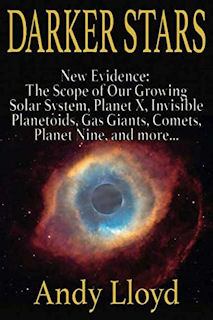Andy Lloyd's Dark Star Blog

Blog 86 (November-December 2021)
Astronomer suggests IRAS May Have Detected Planet X in 1983
A British astronomer has reviewed the IRAS data from way back in 1983 and come up with a possible location for Planet X - around RA 319 Dec 60. While Planet Nine hunters have a candidate target to point their telescopes towards, let's examine how this new evidence came to light:
There haven't been too many sky surveys conducted in infra-red. It's problematic doing them from Earth, even in the coldest climates, because the heat in the environment creates an infra-red fog to peer through into space. Better then to use space-based telescopes, even if they have a relatively limited lifespan.
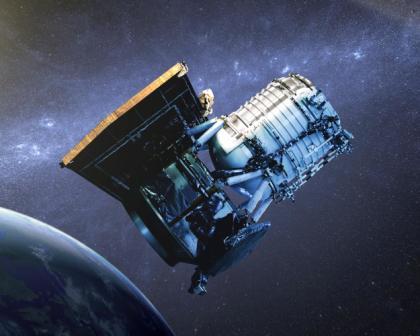
The most effective to date has been WISE. During its tour of duty it appears to have failed to detect Planet X, despite covering a lot of the sky. However, its lifetime was quite short so it may have missed a slow-moving object that would have become more apparent over an extended period of time. After all, it's the variation in position against background stars that makes solar system objects stand out from the crowd. The further away they are, the more difficult they are to spot both in terms of position and reflected luminosity.
It's helpful, then, to consult other sky surveys at other times, to get a clearer picture of how candidate objects may have shifted ground, however marginally. there has been a lot of debate in the Planet X community about whether the 1983 sky survey by IRAS picked out Planet X.
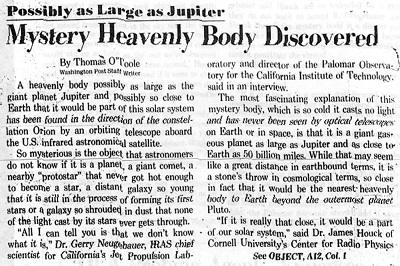
The excitement generated among IRAS astronomers about some mysterious infrared objects (1) were widely reported at the time (2), then sank without trace. In response to the understandable interest in the apparent discovery of a brown dwarf in the solar system back in 1983 (in the constellation Orion), more recent analysis of these articles in the astronomy press have poured cold water over the possible candidate objects.
"...most of the IRAS observations in the 1984 paper were distant, ultra-luminous young galaxies and one was a filamentary structure known as “infrared cirrus” floating in intergalactic space." (3)
However, no actual explanation has ever been forthcoming about what the actual object in Orion was - just that the brown dwarf/massive planet speculation was one among a number of possibilities scientists were considering - at least early on in their deliberations.
Although the above Washington Post article was the most famous of the IRAS anomalies, I've always found the Sagittarius 'sighting' more intriguing, not least because of the way this was reported in the science press in the UK at the time:
"The object's infrared emission shows that it has a temperature of around 230K. This is too cool for a star yet to (sic) hot for a dust cloud. It could be a distant gaseous planet, several times heavier than Jupiter and giving off heat as its own gravity causes it to shrink in size. Whatever it is, say the British astronomers, the Americans have been keeping very quiet about it in recent weeks." (3)
More about this in my books 'Dark Star' (2005) and 'Darker Stars' (2018). Suffice it to say, the position of the candidate object in the sky is also a possible reason why this object has been so difficult to pin down: Sagittarius is the constellation featuring the centre of the Milky Way, which offers a highly luminous and complex backdrop within which to hunt for a distant world. If Planet X is hiding in there, then it's little wonder it's so hard to detect!
Despite the scepticism shown by some scientists about the IRAS data and its possible connection to Planet X (3), other scientists consider it worthwhile to revisit the issue. The result of recent analysis of the IRAS data has provided what could be exciting new evidence:
"Astronomer Michael Rowan-Robinson of Imperial College London in the UK conducted an analysis of data collected by the Infrared Astronomical Satellite (IRAS) in 1983, and found a trio of point sources that just might be Planet Nine. This, Rowan-Robinson concludes in his preprint paper, is actually fairly unlikely to be a real detection, but the possibility does mean that it could be used to model where the planet might be now in order to conduct a more targeted search, in the quest to confirm or rule out its existence." (5)
The scientific paper which Rowan-Robinson has written sets out more detail about his analysis, and rules out most possible anomalies to leave just one candidate (314.83499+64.21527) which could fulfil the criteria for Planet Nine, as it is currently envisaged within the scientific community:
"For a lower mass planet (< 5 earth masses) in the distance range 200-400 AU, we expect a pair or triplet of single HCONs with separations 2-35 arcmin. Several hundred candidate associations are found and have been examined with Scanpi. A single candidate for Planet 9 survives which satisfies the requirements for detected and non-detected HCON passes. A fitted orbit suggest a distance of 225+-15 AU and a mass of 3-5 earth masses." (6)
Rowan-Robinson then plots out the possible path of the elusive planet across the sky in the last 40 years or so, and gently urges astronomers to take a fresh look at this area of sky to see if it's hiding within that zone of interest (~RA 319 Dec 60). Fingers crossed...
Written by Andy Lloyd, 26th November 2021
References:
1) Houck, J. R. et al. "Unidentified point sources in the IRAS minisurvey." Astrophysical Journal, 278: p. L63-L66 (1984)
authors.library.caltech.edu/74851/
2) Thomas O'Toole "Possibly as Large as Jupiter" 30 December 1983
3) Cesar Grossmann "Did The Washington Post confirm Nibiru’s existence?" 2017
4) Martin Redfern and Nigel Henbest "Has IRAS found a tenth planet?" New Scientist, 10 November 1983 Vol. 100:1383, p400
5) Michelle Starr "Mysterious Object Glimpsed Decades Ago Might Have Actually Been Planet Nine" 16 November 2021 with thanks to John
6) Michael Rowan-Robinson "A search for Planet 9 in the IRAS data" 11 Nov 2021 Accepted for publication in MNRAS
The Lunar Bombardment
A new isotopic study of lunar rocks has indicated that the cratering of the Moon's surface occurred by debris left over from the Earth's formation. In a paper that seems to tear up a lot of what is currently thought to have happened in the early solar system, a research team from WWU Münster argue that the lunar bombardment did not take place 3.9 billion years ago as generally thought (1).
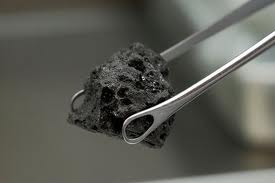
Instead, the impacts occurred much earlier, in the immediate aftermath of the early cataclysms that marked the formation of the Earth/Moon system (2).
""Our research shows that the bombardment of the Moon was by the same bodies that formed the Earth and Moon," explains planetologist and lead author of the study Dr. Emily Worsham. The impact craters on the Moon, therefore, are due to a continuous bombardment of leftover asteroids from the main phase of the Earth's formation. This also allows scientists to rule out a sudden increase in the impact rate due to bombardment with bodies from the outer solar system." (1)
The Late Heavy Bombardment was a cluster of massive bombardments that occurred over a long period of time around 3.9 billion years ago. It is thought to have affected all of the planets and moons in the inner solar system, including Earth. This devastating and sustained bombardment is a mystery because it occurred long after the planets formed 4.5-4.6 billion years ago.
Why did this cluster happen after the solar system had essentially settled down for half a billion years? Many ideas have been put forward, largely to do with a significant migration of the gas giants (an essential component of the Nice model of solar system formation). This new isotopic study of lunar rocks shows that the Moon's impactors did not originate from the outer solar system (the isotopic signatures of ruthenium and molybdenum would have differed significantly if they had). Which means, the scientists argue, that the migratory tussle of the gas giants must have happened very early on. This fits with the Nice model's concept of gravitational interaction with the remnants of the Sun's ptotoplanetary disk.
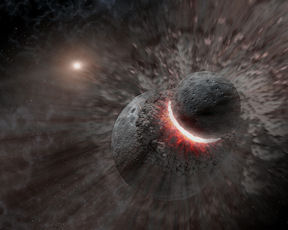
Citing a 1977 article (3), the authors of this new paper pick up the argument that the previously studied lunar rocks (that suggested that dating of the LHB) came mostly from a single impact basin on the north-central Earth-facing side of the moon named the Mare Imbrium (1). This localised sampling then led to a skewing of the dating statistics. To further support this argument, they point out that earlier impact dates have been determined for other lunar craters (4).
However, evidence for the Late Heavy Bombardment is widespread across the solar system. Although the Münster press release seems to tear up the LBH, in the paper itself the authors recognise that it is a reality:
"Nevertheless, the general agreement among the 40Ar-39Ar age frequency distributions of Apollo samples, lunar meteorites, howardite-eucrite-diogenite meteorites (thought to derive from asteroid 4 Vesta), and H chondrites indicates that an LHB occurred and affected the entire inner solar system. Hence, there is no doubt that an LHB occurred, but its origin remains elusive." (2)
So this argument is more about what happened to the Moon in particular, rather than about the more generalised - and mysterious - bombardment that occurred around 3.9 billion years ago.
The central issue here continues to be the need for a trigger event to kick the late bombardment off:
"A cataclysmic LHB would require a dynamic impetus that led to a sudden increase in impact rate." (2)
Absolutely. So, if scientists are ruling out a late migratory event, how could this possibly have happened?
Time to think outside the box. What is rarely - if ever - considered is that the Earth/Moon system might have itself migrated inwards at the start of that bombardment event. As I have written about in my 2019 book 'Darker Stars', some asteroids in the outer main belt also have Earth/Moon isotopic signatures, suggestive of a common origin (5). I have argued that the LBH followed a serious impact and localised gravitational tussle (i.e. with Nibiru and its moons, as suggested by the late Zecharia Sitchin (6)). The resultant debris stream would then account for the subsequent cluster of impacts with objects with Earth/Moon composition.
The intervention of a usurper Planet X object makes a lot more sense than the rather confused arguments that astrophysicists are currently tussling with.
Written by Andy Lloyd, 10th November 2021
References:
1) WWU Münster Press Release "Late bombardment of the Moon revealed" 29 October 2021 with thank to Lee
see also:
2) Emily Worsham and Thorsten Kleine “Late accretionary history of Earth and Moon preserved in lunar impactites”. Science Advances, 7; doi: 10.1126/sciadv.abh2837, 2021
3) G. A. Schaeffer and O. A. Schaeffer "
39Ar/40Ar ages of lunar rocks", in Proc. Lunar Sci. Conf. 8th, 2253–2300 (1977)4) Marc Norman and Alexander Nemchin "A 4.2 billion year old impact basin on the Moon: U-Pb dating of zirconolite and apatite in lunar melt rock 67955" Earth Planet. Sci. Lett. 388, 387–398 (2014)
5) Andy Lloyd 'Darker Stars' Timeless Voyager Press 2019
6) Zecharia Sitchin "The Twelfth Planet" Avon Books 1976
Emerging from the Water World
We have long taken for granted the land masses on Earth. Perhaps less so now as our oceans begin their slow ascent due to anthropogenic global warming. Especially for those living along decaying coastlines or in sea-facing cities. However, scientists have known for some time that the landmasses weren't always there: Very early on in Earth's 4.6 billion year history, the planet transformed from convulsing molten rock to water world. For a long time, the surface of the early Earth was just water. At some point later, land masses began to rise above the planet's global water line. These first continents are known as 'cratons' by scientists.
New research suggests that these cratons emerged much earlier than previously thought. The consensus scientific opinion placed the emergence of landmasses to around 2.5 billion years ago. Now that timeline might be extended back to as early as 3.4 billion years.
"...scientists have found sedimentary rocks — which form from the broken-up bits of other rocks that have undergone erosion and weathering — that date back to that era. Such sedimentary rocks could only form once land broke through the surface of early Earth's oceans." (1)
This new timeline is now much closer to the Late, Heavy Bombardment (LHB) 3.9 billion years ago. Around the time of this extended bombardment the Earth was entirely covered in water. During the bombardment, asteroids/meteorites striking the Earth would have plunged into deep oceans, therefore leaving no surface cratering (not so on the Moon, of course, which still shows the monumental impact of this period of bombardment).
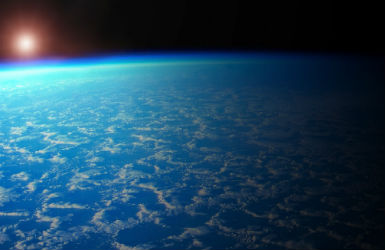
According to Zecharia Sitchin's interpretations of ancient Mesopotamian myth, Babylonian cosmology included a watery planet known as Tiamat (2). This watery planet was rendered asunder by the usurper planet Marduk (associated with a Planet X body often called Nibiru) and its moons. Sitchin asserts that the early, watery Earth was Tiamat; whilst Marduk has disappeared from view.
I've often argued that the LHB was the time of this great Cosmic Battle (3). So it's interesting that Earth's first landmasses arose sometime after the LHB. If Sitchin's account is correct, the early Earth lost a very significant amount of water during its encounter with Marduk (which involved a collision with a small moon described by the Babylonians as the 'North Wind', and an orbital shift inwards). The encounter resulted in vaporised oceans and a spillage of precious water into space. Less water, more likelihood of emerging landmasses...

Also bear in mind recent scientific speculation that substantial fragments of the impactor body may lie deep within the Earth, threading a line from the Pacific Ocean through to West Africa (4).
Written by Andy Lloyd, 17th November 2021
References:
1) Nicoletta Lanese “Earth's 1st continents arose hundreds of millions of years earlier than thought” 8 November 2021 with thanks to Lee
2) Zecharia Sitchin "The Twelfth Planet" Avon Books 1976
3) Andy Lloyd 'The Dark Star' Timeless Voyager Press 2005
4) Andy Lloyd "Theia and Pole Reversals" 28 October 2021
andylloyd.org/darkstarblog85.htm
Water from the Sun?
As with science more generally, the Dark Star website has been debating the origin of Earth's water for a long time (1). What's unusual here is that the anomalies thrown up by the Earth's abundant oceans form part of an argument about the origin of the planet itself. Put simply, the Earth is too close to the Sun to have so much water remaining on it. The water should have been blasted away long ago by heat and the action of the solar wind.
Scientists have long answered this using the 'late veneer' hypothesis whereby water is deposited during the impact of water-rich asteroids and comets. It's a complex offering, with a competing but allied concept of 'late accretion' to consider (2). Either way, the chemical composition of water here on Earth - and among the asteroids and comets most likely to have caused this water-dump - don't match (3). Instead, Earth's water more closely matches asteroids located in the outer asteroid belt.
Picking up on Zecharia Sitchin's notion of a migrating Earth - following a collision during an encounter with a rogue Planet X body and its moons (4) - the whole mystery could be resolved in an Occam's Razor sort of way by assuming that Earth formed where the asteroid belt currently is. Indeed, the belt itself may be debris from the cosmic encounter with the rogue planet, containing chunks of our own planet. The concept of migrating planets is hardly new. Indeed, much of our current cosmology rest upon it (e.g. the Nice model). Earth's formation in this zone would likely require Jupiter to have formed a bit further out, but this is hardly beyond the realm of possibility either.
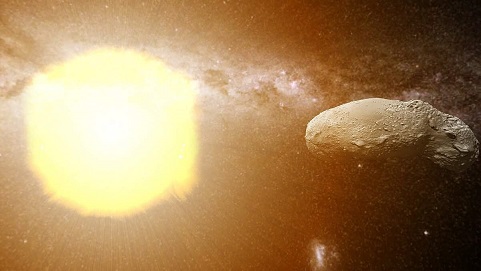
Image Credit: Curtin University
Recent scientific work may offer an alternative explanation - at least partly. Instead of comets and asteroids being the vectors for water delivery, how about the solar wind? Space dust is prevalent throughout the solar system (seen in the so-called zodiacal light'). The action of the solar wind can ionise hydrogen into protons, allowing chemical reactions on the surface of dust grains which can lead to the production of water. This concept has been used to account for anomalously high water content distributed within the dusty regolith on the Moon's surface
"“We think of water as this special, magical compound,” said William M. Farrell, a plasma physicist at NASA’s Goddard Space Flight Center ... “But here’s what’s amazing: every rock has the potential to make water, especially after being irradiated by the solar wind.”" (5)
That chemical activity also appears to be happening on asteroids. Scientists examining samples from Japan’s Hayabusa spacecraft mission, which brought part of the asteroid Itokawa to Earth in 2010, have determined that the isotope ratio of water has been unexpectedly skewed (6). They consider this to be a result of the action of the Solar Wind providing an 'additional isotopically light reservoir' of proton-rich hydrogen ions, and thus water:
"We used atom probe tomography to directly observe an average ~1 mol% enrichment in water and hydroxyls in the solar-wind-irradiated rim of an olivine grain from the S-type asteroid Itokawa. We also experimentally confirm that H+ irradiation of silicate mineral surfaces produces water molecules. These results suggest that the Itokawa regolith could contain ~20 L m−3 of solar-wind-derived water and that such water reservoirs are probably ubiquitous on airless worlds throughout our Galaxy." (7)
It's a big jump from this finding to water generation on a planet wrapped with a significant atmosphere, like Earth. After all, the chemical reactions take place on the rock which, on Earth, is shielded from proton bombardment. Further, water created during the primordial Earth phases would be subject to drying activities by the Sun. This abundant delivery system should also have profound repercussions for water on Mars, surely?
At the moment it seems reasonable to conclude that Earth's weird water remains an anomaly.
Written by Andy Lloyd, 7th December 2021
References:
1) Andy Lloyd 'The Great Water Conundrum' 2nd April 2002
2) Alessandro Morbidelli & Bernard Wood "Late Accretion and the Late Veneer" 17 Nov 2014
3) Michael Drake & Kevin Righter “Determining the composition of the Earth” Nature, 416: 39-44 (7th March) 2002
4) Zecharia Sitchin "The Twelfth Planet" Avon Books 1976
5) Lonnie Shekhtman "How Ingredients for Water Could Be Made on the Surface of Moon" 20 February 2019
6) Ellen Phiddian "Did Earth get its water from… the Sun?" 30 November 2021 with thanks to Lee
7) Luke Daly et al "Solar wind contributions to Earth’s oceans" Nat Astron, 29 November 2021
A Myriad of Rogue Planets
Spotting exoplanets orbiting other stars has become so commonplace an activity that new additions to the cast of thousands are barely mentioned anymore. Indeed, the emphasis has shifted more towards whether we'll be able to detect telltale signs of life on them. Once fully operational, the recently launched James Webb space telescope will likely provide some incredibly tantalising data about many of these distant worlds.
The growing back-catalogue of exoplanets is mostly comprised of worlds that orbit stars. Indeed, their proximity to their parent suns has enabled their detection in many cases. Minute but regular star wobbles, tiny routine dips in light, and sometimes even a reflective glimmer in young star's dust disk. However, there is a whole category of stars which remain in the shadows - rogue planets. These cold, isolated worlds drift through the vast desert of interstellar space between the stars, most likely ejected from their home stars when they were but pups. Discovering them is difficult, but has been accomplished in the past. A new study by ESO teams working at several observatories has revealed between 70 and 170 new free-floating planets, depending on the age assumed for the explored region ( a patch of sky taking in upper Scorpius and Ophiucus) (1)
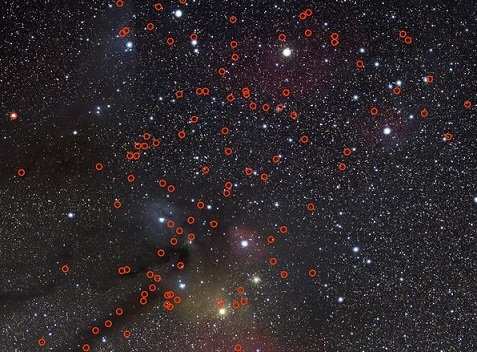
Image Credit: ESO/N. Risinger
Previously, forensic examination using complex computer simulations of other star clusters has led astrophysicists to predict how many rogue planets might be floating around unseen within the herd. Such forays have led to figures like 50 billion free-floating planets out there in the Milky Way (2). But coming up with a number for the galactic population is tricky, with many question marks remaining. That's why it so helpful to actually spot the blighters out there in the darkness, particularly when they're young and relatively bright.
"“There could be several billions of these free-floating giant planets roaming freely in the Milky Way without a host star,” [Hervé] Bouy [an astronomer at the Laboratoire d’Astrophysique de Bordeaux] explains. By studying the newly found rogue planets, astronomers may find clues to how these mysterious objects form. Some scientists believe rogue planets can form from the collapse of a gas cloud that is too small to lead to the formation of a star, or that they could have been kicked out from their parent system. But which mechanism is more likely remains unknown." (1)
Many of the new rogue planets observed by ESO fall into the category of brown dwarfs - sub-stellar objects which have masses between 13 and 80 Jupiter masses. There are at least 70 of these new objects in this patch of sky. However, the age of the region is uncertain, which complicates matters. If the study region is (relatively) old, then the 70 objects is a considerable under-estimate (3). This is because many sub-brown dwarfs will have cooled down sufficiently to become invisible to us - the objects below 13 Mj are now dark, and so won't have been spotted in this search. Interestingly, the implicit conclusion here is that there are likely to be many more objects between, say, 3Mj and 13Mj (the objects I call 'Dark Stars') than between 13Mj and 80Mj. This has been argued recently elsewhere (4).
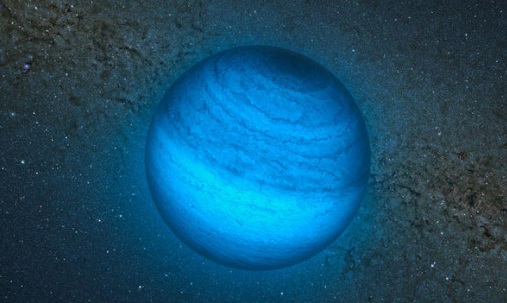
Image credit: ESO/L. Calçada/P. Delorme/Nick Risinger/R. Saito/VVV Consortium
So, here's the thing. There is an abundance of massive planets floating around in interstellar space. Fact. Interstellar space is mind-wrenchingly vast, so the chance of one of these worlds making a close flyby of a star is low, but not negligibly low. The more Dark Stars there are out there, the more likely they make such flybys, particularly within early, chaotic star-birthing regions (5). As a result, any examination of our own Sun's early history should include a non-zero potential for such an event to have occurred - with potentially important repercussions.
Written by Andy Lloyd, 26th December 2021
References:
1) European Southern Observatory "ESO telescopes help uncover largest group of rogue planets yet" 22 December 2021
2) Paul Scott Anderson "There may be 50 billion free-floating planets in our galaxy" 10 March 2019
3) Nuria Miret-Roig et al. " A rich population of free-floating planets in the Upper Scorpius young stellar association"
4) Wittenmyer, R. A. et al. "Cool Jupiters greatly outnumber their toasty siblings: occurrence rates from the Anglo-Australian Planet Search", Mon. Not. R. Astron. Soc., 492(1): 377–383, February 2020
5) Long Wang et al. "Close encounters involving free-floating planets in star clusters", Monthly Notices of the Royal Astronomical Society, 449(4): 3543–3558, June 2015
Quest for the Humanzee - The Anunnaki Connection
As well as bringing this blog up into the mobile age, I've been overhauling my original Dark Star website darkstar1.co.uk. As part of that effort, I've substantially updated one of my essays from 2005. It's good to breathe some new life into what was such a popular website. The updated article is about human-ape hybridisation, and you can read more here:
Timeless Sitchin
A rare 1990 radio interview with Zecharia Sitchin has been made available free online.
In this interview, circa 1990, Bruce Stephen Holms - host of Timeless Voyager Radio - asks Zecharia Sitchin many questions about the Sumerian's record of the Anunnaki. Holms's interviewing style makes it easy to listen to the dialogue which investigates the "pre-history" of humans. According to Sitchin, who is one of a handful of people who can read and translate the Sumerian language believes that these "historical" records are not mythology but rather a long history of pre-human existence on our planet by extraterrestrials.
Zecharia Sitchin author of a number of books proposing an explanation for human origins involving ancient astronauts. Sitchin attributed the creation of the ancient Sumerian culture to the Anunnaki, which he stated was a race of extraterrestrials from a planet beyond Neptune called Nibiru. He asserts that Sumerian mythology suggests that this planet Nibiru has an elongated, 3,600-year-long elliptical orbit around the sun. Sitchin says that the Annunaki lived on Earth for 300,000 years before they (the Anunnaki) genetically created mankind.

